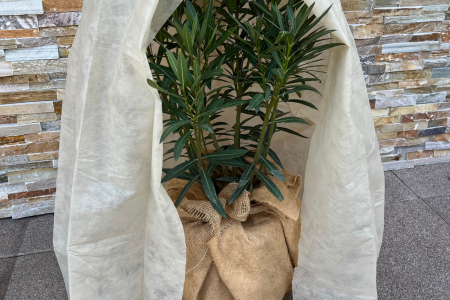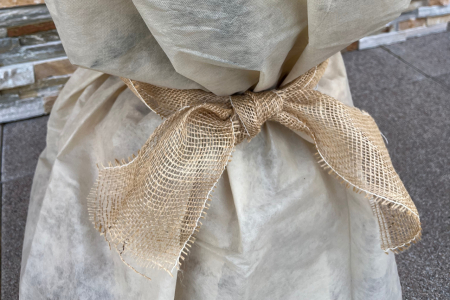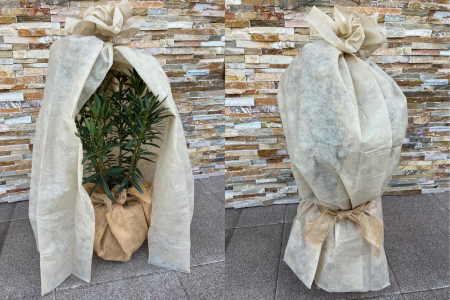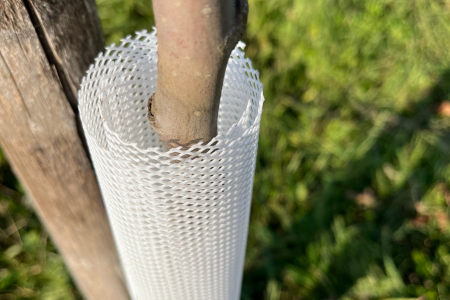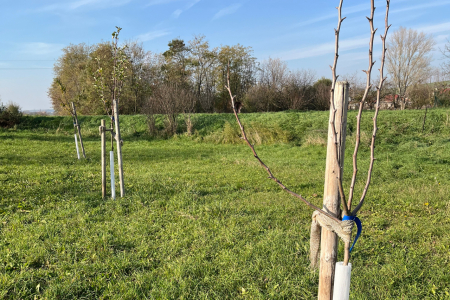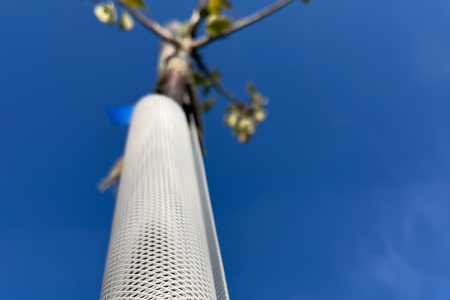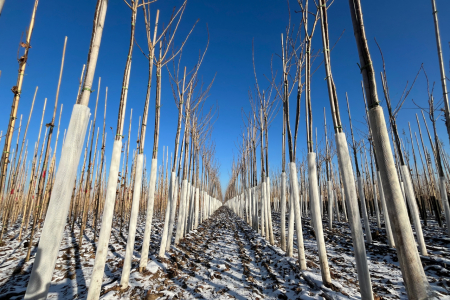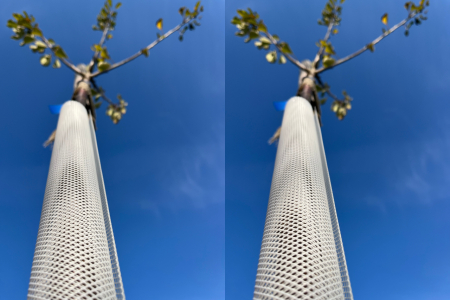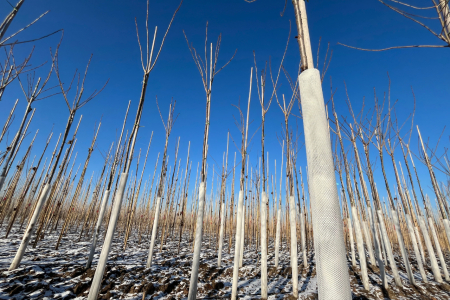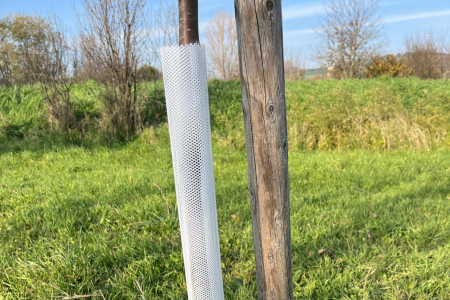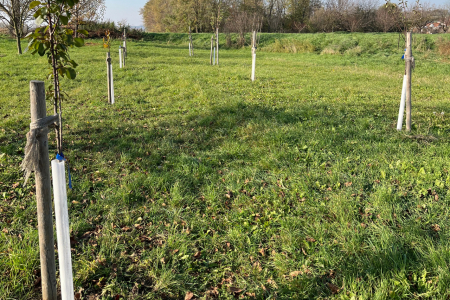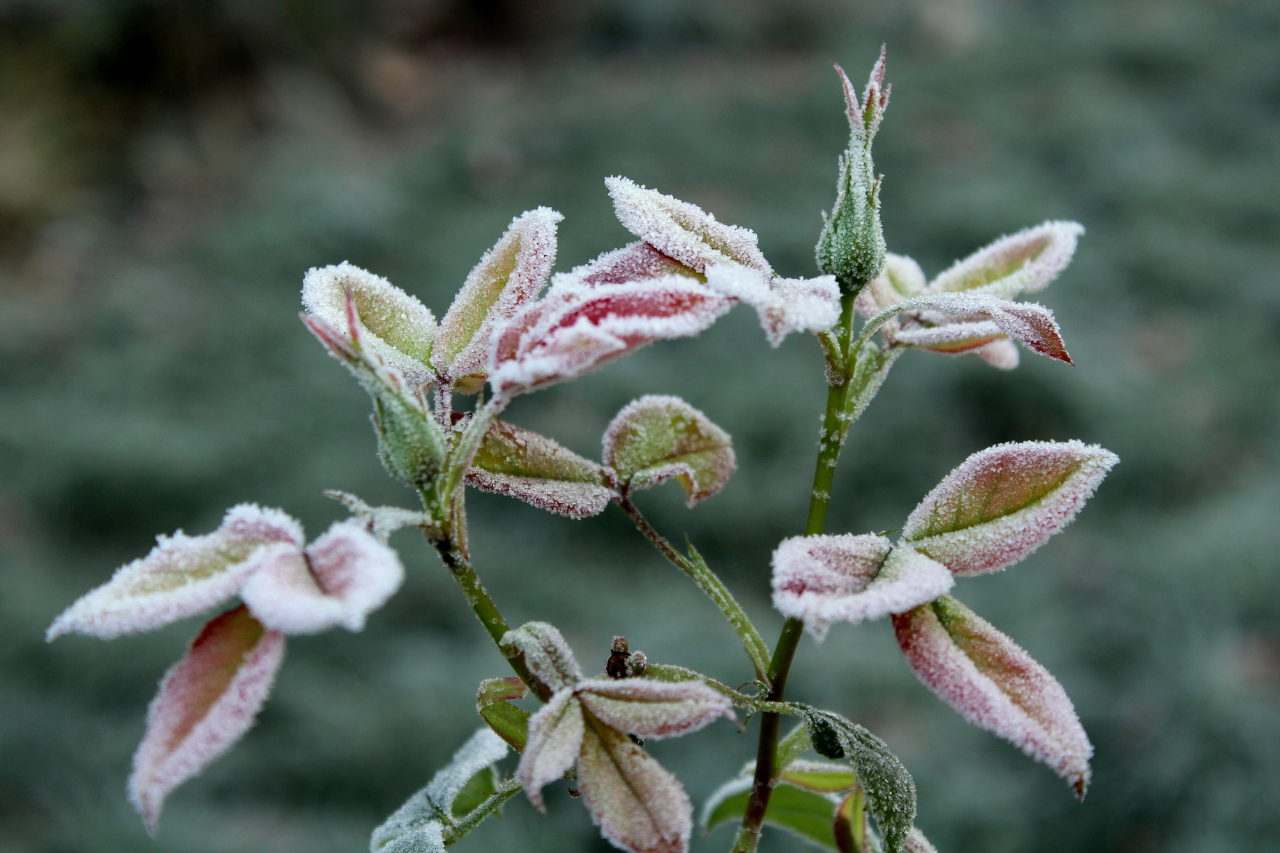
Ground frost occurs when the temperature drops below freezing just five centimeters above the ground, while remaining above freezing a bit higher (approx. 2 metres above the ground).
If the weather forecast predicts ground frost, it’s time to head to your garden and get it ready. Here are six methods to protect your garden from frost.
1. Nonwoven Frost Protection Fabric
Let's start with the easiest frost protection method for gardeners — nonwoven fabric. This lightweight white fabric is your plants’ best defence against ground frost. Simply wrap it around the crowns of smaller flowering trees.
To protect the seedlings, cover them entirely with the fabric. Just make sure not to crush the plants underneath.
When stronger frosts are expected, double up the fabric layers for better protection or use a heavier beige covering fabric (30 g). It’s also a popular frost protection for plants in pots and other movable containers.
Traditional dark nonwoven fabric, like the one you might use in strawberry fields, isn’t suitable for frost protection. It's heavier, which could damage delicate plant parts, and it absorbs light which doesn’t get to the plants underneath. Plants covered with dark fabric would stay in the dark. That’s why white fabric is a much better choice.
Ground frosts typically strike early in the morning and may linger for several hours.
Light fabric is also ideal when frost is expected for multiple days in a row and you don’t want to put the fabric on and take it off constantly. It allows light to pass through, so if you leave plants wrapped for a few days, they won’t be harmed. Moreover, light fabric reduces water evaporation, meaning you don’t need to water your covered seedlings as often.
Please bear in mind that in colder weather, the temperature under the covering fabric can increase by up to 3°C, and in warmer weather, it could rise even more. These favorable conditions accelerate plant germination and growth — giving those wrapped in fabric a head start of 2–3 weeks over their uncovered counterparts.
2. Tree Trunk Frost Protectors
One effective way to delay the spring awakening of trees is using white tree trunk protectors. The white color reflects light, preventing the tree trunks from overheating by fending light off.
For more details, check out our article on tree frost protection.
3. Heating the Air
Fruit growers sometimes resort to making fires that they keep throughout the night, or to lighting paraffin candles. However, this method can be costly as 350 candles are needed per hectare.
4. Water Spray
Some gardeners take on frosts by spraying plants with a fine water mist. This creates a thin ice crust on the plants that protects the buds and flowers from freezing.
Our customers who purchase white tree trunk protectors often use water spray for enhanced protection of their trees.
5. Water and Glycerol Spray
A more refined approach involves spraying with a mixture of water and glycerol. The spray creates a mist that protects the plants from frost. This method has its limits as it works only when it’s not windy and when the frost is not too severe.
6. The Right Planting Location
Protection against ground frost goes all the way back to choosing the right location where you plant your crops. Delicate plants can be placed on raised beds where temperatures are generally higher than right at the ground level. Additionally, you can use white or beige protective fabric to shield the plants if needed.
Or place your plants in front of a sunlit wall. The wall absorbs heat during the day and gradually releases it into the surroundings at night. This creates a warmer microclimate compared to the rest of the garden.
For potted plants left outside over winter, make sure to think about their proper placement in the fall. You can also wrap the pots in burlap fabric for added protection. For more information, check out our article on winterising your garden.
Will There Be Ground Frost? How to Find Out
When it comes to frost, early action is key. Keep an eye on local weather services, such as meteorological institutes' websites, or check their current heat maps.
Be especially cautious if your garden lies in a valley, as cold air tends to settle there.
Frost risk gets higher during clear, windless nights or when a temperature inversion occurs (warmer air above cooler air). Frosts are also more dangerous if they come after a warm period when plants have already developed buds and flowers.
Frost risk generally lasts until mid-May (the "Ice Saints" feast days). In higher altitudes, it may persist even longer.
Frost Damage Risk is Higher in Europe
An international team of scientists studied how trees cope with late spring frosts. They found that trees in eastern North America are less vulnerable to frost as temperature drops are common and the trees there have developed "late-budding" leaves.
Conversely, in Europe and Asia, stronger frosts later in spring were not common historically. Trees here are early-budding, more susceptible to frost damage.
The research, which included scientists from the Czech Academy of Sciences, examined spring frosts between 1959 and 2017. It concluded that frost damage would increase by 35% in European and 26% in Asian temperate forests, while North America is expected to see a smaller rise of just 10%.
We Supply Frost Protection Fabrics
At Milmar, we process nonwoven fabrics and mesh to create products for homes, gardens, and various industries. We supply wholesale garden equipment distributors and large-scale growers. Additionally, we also offer custom packaging under your own brand.
